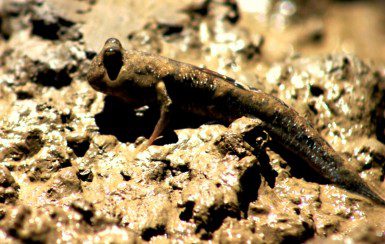By Charlie Gough, Marine Research Coordinator, Belo-sur-Mer, Madagascar. The word “swamp” conjures vivid images of squelching muddy bogs, sulphurous eruptions, and mosquitos laden with fever inducing parasites. However the mangrove swamps of western Madagascar have a much more ethereal quality than the swamps of the mind. These emerald cities nestled in enclaves along the west coast house some of the world’s weirdest and wonderful plants and animals.
Mangroves are known for their ability to survive in some of the harshest environments in nature where for half the day they are inundated by the muddy coastal waters and for the other part they are exposed to the desiccation potential of the tropical sunshine. The trees themselves are adapted to live in these salt rich conditions through numerous evolutionary adaptations including the excretion of salt in a single sacrificial leaf, or through stilted roots or underground pneumatophores that reach up through the mud and water to enable the plant to breathe.
Blue Ventures’ intrepid Belo team is currently undertaking a broad assessment of the status of the mangroves of the Kirindy Mite region, an area that stretches from Andranopasy in the south, over 100km north to Andika, in the Menabe region south of Morondava.
On a recent excursion to the southernmost mangroves of Andranopasy the team spent over 5 hours a day trekking through dense and humid mangrove forests, trying to avoid some of the more unappealing inhabitants such as wasps (kitoke), and mosquitoes (moky) and the barnacles and oysters affectionately referred to as teeth (hy) that grow on the stilted roots of Rhizophora mucronata (Tangandahy). Whilst at the same time being mesmerised by the daily antics of the numerous species of butterfly, birds, and crabs and of course the comical goggle-eyed mudskipper (tsabibiky) that make their homes in these muddy swamps.
The mudskipper (of the Gobidae family) is the most endearing of the mangrove characters, with its bulging eyes and pursed lips it emerges from its holes in the baking mud as the tide begins to return. This amphibian-fish propels itself across the mud from pool to pool using its bizarrely shaped pectoral fins, twisting sporadically in the air in order to maintain a watery layer over its mucous skin so that it can breathe.
While the mudskipper is too small to attract the attention of fishers, other mangrove fish species and crabs are not so fortunate, with mangrove fisheries being a large source of food and income for the local community. During their time in Andranopasy the team also set up a fisheries monitoring programme to assess both the mangroves and offshore fisheries, to try to observe the effects of the new Madagascar National Park (MNP) Category II permanent reserve (noyaux dur).
The mangrove trees themselves are also used by local communities both to build homes and fences, as well as for their many traditional medicinal qualities. But, as human populations grow exponentially, mangrove forests are become increasingly over exploited in many areas, Andranopasy being no exception, with some areas of the forest being severely overharvested. A local association called Vondron’olona ifotony (VOI) was set up in 2008 by Bird Life International and they work to try to manage some areas of the mangrove of Andranopasy, however their capacity is small and they have little ongoing support and the harvesting of mangroves in the area appears to be continuing to a large extent.
Climate change also threatens these majestic forests. As waters warm and sea levels rise the areas available for mangroves to inhabit are reduced. Very little information is know about mangroves in Madagascar and Blue Ventures, with Madagascar National Parks (MNP) and local communities, are undertaking this research to look at the current status of these forests and identify effective solutions to natural resource extraction that might conserve these habitats for future generations.



